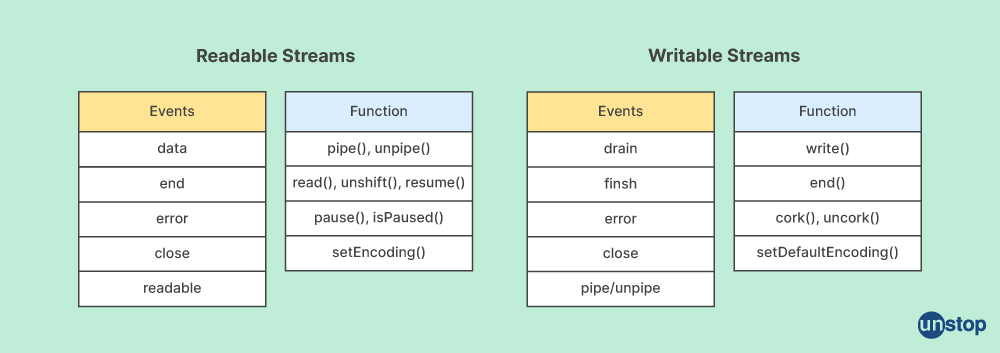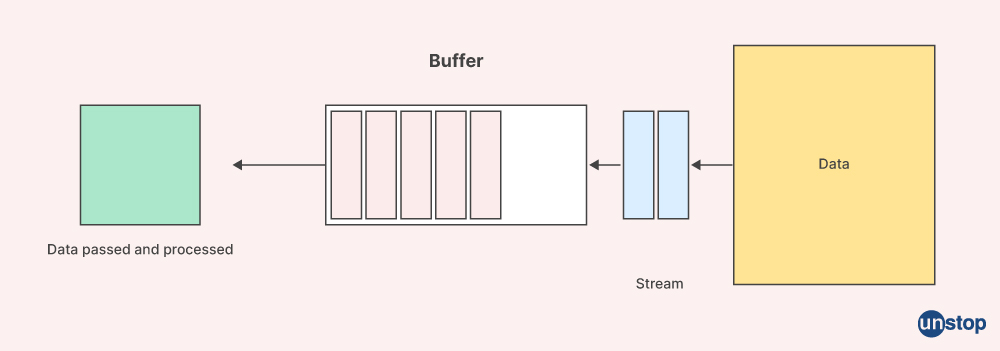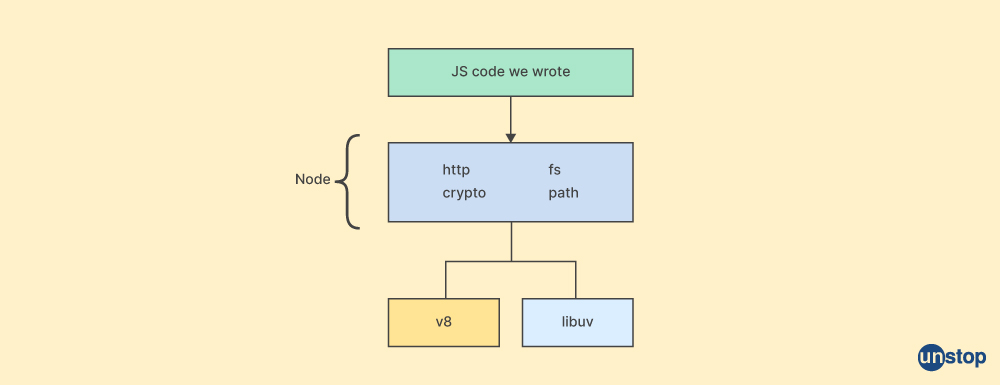- Basic Node.js Interview Questions
- Node.js Interview Questions: Intermediate
- Node.js Interview Questions: Advanced
50+ Essential Node.js Interview Questions With Answers 2023

Node.js is an open-source, cross-platform environment that makes it possible for the JavaScript code to be run outside of a browser. It is mainly used for back-end processes like web apps or APIs. It was developed by Ryan Dahl in 2009 and is built on Chrome's V8 JavaScript engine. Node.Js has an active community in the coding world.
In this article, we have curated some important node.js interview questions which are frequently asked across companies and job profiles. You must go through this blog to brush up on your node.js skill and crack that interview with ease.
Basic Node.js Interview Questions
Q1. Define node.js in a few lines.
Node.js is a JavaScript runtime environment that enables programmers to create scalable server-side applications. It is cross-platform and free to use for all. Node.js applications are written in javascript, and it is built on Chrome's V8 engine.

Example of code written in node.js:
CODE SNIPPET IS HEREY29uc3QgaHR0cCA9IHJlcXVpcmUoJ25vZGU6aHR0cCcpOwoKY29uc3QgaG9zdG5hbWUgPSAnMTI3LjAuMC4xJzsKCmNvbnN0IHBvcnQgPSAzMDAwOwoKCgoKY29uc3Qgc2VydmVyID0gaHR0cC5jcmVhdGVTZXJ2ZXIoKHJlcSwgcmVzKSA9PiB7CgpyZXMuc3RhdHVzQ29kZSA9IDIwMDsKCnJlcy5zZXRIZWFkZXIoJ0NvbnRlbnQtVHlwZScsICd0ZXh0L3BsYWluJyk7CgpyZXMuZW5kKCdIZWxsbywgV29ybGQhXG4nKTsKCn0pOwoKCgoKc2VydmVyLmxpc3Rlbihwb3J0LCBob3N0bmFtZSwgKCkgPT4gewoKY29uc29sZS5sb2coYFNlcnZlciBydW5uaW5nIGF0IGh0dHA6Ly8ke2hvc3RuYW1lfToke3BvcnR9L2ApOwoKfSk7
Q2. Tell me where you can not use Node.js.
While Node.js has quite a few applications, there are a few cases where it is not efficient to use it. For example-
Real-Time Gaming Engine: We cannot use node.js in real-time gaming engines and other applications that require extremely low latency. These kinds of applications need to acquire fine-grained control over low-level system resources. And this can be difficult to accomplish with Node.js.
CPU Intensive: Node.js is a single thread and employs a non-blocking, event-driven I/O architecture. As a result, it is more appropriate for I/O-bound applications rather than for CPU-bound jobs.
Q3. Can you tell me the name of some companies that use Node.js?
Some companies that use node.js are PayPal, LinkedIn, Netflix, Uber, Walmart, Twitter, Yahoo, eBay, etc.
Q4. Can you mention some features of Node.js?
Some features of Node.js are:
- It is an asynchronous and event-driven architecture.
- The Node.js environment facilitates scalability, that is, it is scalable.
- It has cross-platform compatibility.
- Code execution in Node.js is very fast.
- Node.js is a single-threaded model with event looping.

Q5. List some of the applications that use Node.js.
Some applications that can be built using the Node.js environment are:
- Real-time chat applications
- Social media platforms
- Internet of Things (IoT) applications
- Streaming applications
- Online payment processors
- Remote collaboration tools
- Single-page applications (SPAs)
- Real-time web applications
Q6. Tell me the difference between Node.js and Ajax.
|
NODE.JS |
AJAX |
|
Node.js is an open-source framework. |
Ajax is a web development technique. |
|
It can only be written in Javascript. |
|
|
Node.js always works on server-side applications. It is used for real-time applications. |
Ajax works only on the client side. |
|
It supports dependency injection. |
It does not support dependency injection. |
Q7. Tell me some benefits of using Node.js.
The advantages of using Node.js are:
- Scalability: Node.js is very scalable and can expand along with the company/ entity using it. Also, it is easier to scale in comparison to other backend event mechanism technologies. For example, compared to traditional servers like Apache HTTP Server that have limited threads, the same single thread can handle a far higher volume of requests.
- Fast and light: For legacy systems, Node.js is lightweight and quick by nature. It is also comparatively faster hence making it a popular choice.
- Long-term support: Node.js offers long-term support, which is important for enterprises that need various access permissions.
Q8. Tell me some disadvantages of using Node.js.
Some of the most prominent disadvantages of using Node.js are:
- Unstable API: One of the biggest shortcomings of Node.js is the high frequency of API updates that lead to a lack of stability for anyone using it.
- Lack of library support: Another disadvantage of using Node.js is that its system for supporting libraries is weak.
- Asynchronous programming model: For developers who are unfamiliar with it, async function programming can be difficult.
Q9. Name some of the common utility functions in Node.js.
Some common utility functions in Node.js are-
| util.format() | util.promisify() |
| util.debuglog() | util.callbackify() |
| util.inspect() |
These were a few Node.js questions you may get asked during an interview. All freshers, as well as experience holders, must prepare well for basic, intermediate, and advanced-level questions.
Node.js Interview Questions: Intermediate
Q10. Describe npm.
Npm stands for Node Package Manager, which is the default package manager for the JavaScript runtime environment Node.js. It is a library and registry for JavaScript software packages. Npm is used to manage dependencies in Node.js projects.
Q11. Describe REPL.
REPL in node.js stands for Read-Eval-Print-Loop. It is a programming language environment that accepts a single expression from the user (i.e., reads the user's input) and executes it (i.e., evaluates the input and data structure), before returning the result to the console.

Q12. Tell me about streams.
Stream is one of the most important concepts in Node.js, and anyone prepping for an interview must prepare for such questions.
Streams are objects that enable continuous data reading from a source which is then written to another destination. There are 4 primary types of streams in Node.js, namely- Readable, Writable, Duplex, and Transform streams. The use of streams makes the process of reading and writing files more efficient and comparatively easier. It also facilitates communicating over networks or exchanging any kind of end-to-end information.

Q13. Tell me some of the advantages of using Stream.
Some advantages of using stream are:
- They allow data to be exchanged in small chunks, thus significantly reducing memory consumption.
- Another advantage is that streams send files in chunks, and each chunk is processed separately, which makes them more time-efficient than other data handling methods.
- Streams also give developers the power of composability in their code. Just like powerful Linux commands that can be composed by piping other smaller Linux commands, the same can be done in Node.js with streams.
Q14. Can you explain the different types of streams in Node.js?
There are four types of streams in Node.js which are-
Readable stream:
Readable streams are used for read operations. They are an abstraction for a source from which data can be read, such as a file or a network socket. Examples of readable streams include fs.createReadStream() and process.stdin.
Writable stream:
Writable streams are used for write operations. They are an abstraction for a destination to which data can be written, such as a file or a network socket. Examples of writable streams include- fs.createWriteStream() and process.stdout.
Duplex stream:
Duplex streams are both readable and writable. They are an abstraction for a source-destination pair, such as a network socket. Examples of duplex streams include net.Socket and process.stdio.
Transform stream:
Transform streams are a type of duplex stream that can be used to modify or transform the data while it is being written and read. They are an abstraction for a source-destination pair that modifies the data in some way. Examples of transform streams include zlib.createGzip() and crypto.createCipher().

Q15. Define the test pyramid.
The Test Pyramid is an illustration that instructs us to divide software tests into granularity-based buckets. It does so by providing an estimate of the number of tests we should include in each bucket. The pyramid attempts to visually represent a logical organization of testing standards. It consists of three distinct layers, namely- the unit tests, the integration tests, and the end-to-end tests. The concept of the test pyramid was established by Mike Cohn.

Q16. Explain promises.
An asynchronous operation's value or async code and future completion (or failure) are represented via an object known as a promise. In simple terms, promises are an enhancement of callbacks, which control all asynchronous data actions. An action is represented by a JavaScript promise, which will either be accepted or rejected. The promise is resolved if it is kept; if not, it is rejected.
Promises are an enhancement to the callback pattern that makes creating asynchronous code simpler. They are employed while running asynchronous programming for control flow and error handling.
Q17. Tell me the types of API functions that are available in node.js.
There are 2 types of API functions that are available in node.js, namely, asynchronous/ non-blocking functions and synchronous/ blocking functions.
Asynchronous/ non-blocking functions:
The execution of asynchronous functions prevents the Node.js library from being blocked while they wait for data to come in from the API. A Node.js event notification mechanism will be used to inform the server of the previous API call, and it will then call the succeeding API before going on to the next one. These features let the employees keep working on the tasks at hand while the request is being processed.
Synchronous/ blocking functions:
The event-based model loop is blocked while synchronous functions are in use until the operation is finished. Blocking functions, or synchronous functions, prevent the program from continuing to run until all processing has been completed.
Q18. Define a stub.
A test double, known as a stub in Node.js, replaces a function with a pre-programmed response. It is a little program routine that takes the place of a lengthier program that might need to be loaded later or is located elsewhere. Stubs are test-only mock objects that carry out a pre-programmed behavior. They can be used to direct the behavior of a method from a test to steer the code in a particular direction. Also, note that when a stub is used to wrap an existing function, the original function is not called. Stubs are particularly helpful when one is testing code that depends on external services that might not be available.
Q19. What is the purpose of the underscore variable in REPL in Node.js?
Firstly, in Node.js, REPL stands for Read Eval (evaluate) Print Loop. The underscore is a special variable that is used to hold the outcome of the last evaluated expression in the Node.js REPL. This indicates that whenever a command is entered in the REPL, the underscore variable may be used to obtain the output of the previous expression.
Q21. Tell me about the callback method and callback hell term used in Node.js.
Callback method :
A call-back function is a type of node.js function that will receive an argument from another function, and it intends to be called at a later time. These methods are used to manage asynchronous tasks and to prevent blocking of the event mechanism loop.

Callback hell :
The circumstance when numerous callbacks are nested inside of one another and make the code challenging to comprehend and maintain is referred to as "callback hell." This occurs when nested callbacks are complex, and each callback accepts an argument that is the outcome of the callbacks before it, resulting in a pyramid-like structure.
Callback hell example:
CODE SNIPPET IS HEREZnMucmVhZEZpbGUoJ2ZpbGUxLnR4dCcsIGZ1bmN0aW9uKGVyciwgZGF0YSkgewoKaWYgKGVycikgewoKY29uc29sZS5lcnJvcihlcnIpOwoKfSBlbHNlIHsKCmZzLnJlYWRGaWxlKCdmaWxlMi50eHQnLCBmdW5jdGlvbihlcnIsIGRhdGEpIHsKCmlmIChlcnIpIHsKCmNvbnNvbGUuZXJyb3IoZXJyKTsKCn0gZWxzZSB7Cgpmcy5yZWFkRmlsZSgnZmlsZTMudHh0JywgZnVuY3Rpb24oZXJyLCBkYXRhKSB7CgppZiAoZXJyKSB7Cgpjb25zb2xlLmVycm9yKGVycik7Cgp9IGVsc2UgewoKY29uc29sZS5sb2coZGF0YSk7Cgp9Cgp9KTsKCn0KCn0pOwoKfQoKfSk7
Q22. Define event-driven planning in reference to Node.js.
Event-driven programming/ planning is a logical pattern that we can choose to confine our programming within to avoid issues of complexity and collision. When compared to other similar technologies, Node.js is faster because it makes extensive use of events. When a Node.js server is launched, it first initializes the variables and functions before listening for an event to occur.
An event-based model loop contacts the appropriate event handler when it detects an event trigger. Node.js provide several built-in events, which can be accessed using the 'events' module and the EventEmitter class.
Q23. Tell me about the components of NPM.
The term NPM stands for Node Package Manager. There are three primary components of NPM, namely- the registry, the CLI, and the website.
- The registry is a collection of packages available for NPM installation.
- The tool used to work with the registry and install packages is the CLI, i.e., the command-line interface.
- The website serves as a search and browsing tool for registry packages.
Also, when a package is installed with the NPM, it is kept in the node_modules subdirectory of the project.
Q24. What are blocking and non-blocking programs in Node.js?
Blocking program in Node.js:
Blocking refers to the blocking of all further executions until the current operation finishes. That is, the blocking programs in Node.js block the execution until the exiting process completes. In comparison, non-blocking refers to code that doesn't block execution.
Blocking methods are executed synchronously, meaning that the program is executed line by line, and the program waits until the called function or the operation returns.
Non-blocking program in Node.js:
The non-blocking operations execute async functions. Therefore, the program may occasionally not run line by line. Here, instead of waiting for the non-blocking method to return, the program instead calls it and moves on to the next action.
Q25. Can you describe the buffer concept in Node.js?
A Buffer module in Node.js is a temporary memory location where binary data is kept. Buffers are used to carry out actions on unprocessed binary data, for reading from or writing to streams, or for fine-grained data manipulation. In simple terms, the Buffer module class in Node.js is used to perform operations on raw binary data.
There are several ways to generate buffers, such as using the alloc() function to set their size at creation and the from() method to create a buffer from the text. It is important to note that the buffers cannot be resized.

Q26. What do you mean by piping the stream?
The Node.js piping method allows one stream's output to be used as the input for another stream. In other words, the piping technique is typically used to obtain data from one stream and transfer that stream's output to another.
Multiple processes can be made simpler by piping streams. The pipe() technique is risky, meaning that piping is a safer method to use. Since stream.pipeline() correctly cleans up once the pipeline has completed passing errors and provides a callback. We may use it in place of pipe(). Also, the number of times the data can be piped from an output stream to an input stream is not limited.
Q27. Discuss what is meant by chaining the streams.
In Node.js, the chaining method refers to the act of connecting one stream's output to another and building a chain of operations for many streams together. The Pipelining method frequently employs chaining. A file can be compressed and decompressed using the chaining technique. The data can also be transformed in a variety of other ways. It can be used to establish a chain of operations for several streams and can assist in reducing the complexity of numerous stages.
All in all, a chain of operations for several streams can be created by connecting the output of one stream to another stream via chaining, and the data can be continuously read from a source and written to a destination.
Node.js Interview Questions: Advanced
Q28. Explain what is the libuv library. Also, mention some features of Libuv Library.
Node.js library utilizes the C library libuv to abstract non-blocking I/O operations to a uniform interface on all systems that are supported. It plays a significant role in the Node.js runtime environment and manages asynchronous, non-blocking operations.

The features of libuv library are:
- The Libuv library provides various mechanisms to handle services like File Systems, DNS, networks, child thread processes, pipes, signal handling, polling, streaming, and more.
- The library also includes a thread pool which helps distribute the CPU loads for blocking operations that can't be done asynchronously at the OS level.
Q29. Can you tell me about spawn() and fork() method in node.js?
The Spawn() Method: This method first initiates a command in a new process and creates a child thread process that implements the EventEmitter API. It thus returns an instance of the child process. The handlers for events can then be attached or registered to the child instance created. Note that in spawn(), only one copy of the node module is active.
The syntax for the spawn() method in Node.js is-
child_process.spawn(command[, args][, options])
The Fork() Method: This method is a special case of the spawn() method. It generates a new V8 heap engine instance and creates a new process through command rather than running on the same node process. The fork() method can make several individual processes (child thread processes) and multiple workers run on a single node module.
The syntax for the fork() method in Node.js is-
child_process.fork(modulePath[, args][, options])
Q30. Tell me about the tool you would use to assure consistent style in Node.js.
There are multiple tools in Node.js that can be used to assure a consistent style that helps develop code in teams. Some of them are-
- Node.js Standard Style: To make sure that files adhere to the Node.js core style guidelines, we can utilize the Node.js Standard Style tool.
- ESLint: ESLint is a well-known tool that can be utilized to enforce coding standards and find common errors in JavaScript code.
- Prettier: This is a code formatting tool that is helpful in making sure that code is formatted consistently as per Node.js guidelines.
- Editorconfig: EditorConfig is a tool that can be used to make formatting preferences in an editor mandatory.
- RisingStack's Node.js style guide: RisingStack's Node.js style guide outlines indentation guidelines, variable naming conventions, best practices, and other details to make sure that code is written consistently.
Q31. Describe the global and local installation of dependencies.
Global Installation: The global installation of dependencies puts the module into our Node.js path, which is operating system dependent. This makes it accessible from any project without the need to install it separately for each project while doing the setup.
Global installation of dependencies is used to install packages globally in the system while making Node projects. Global installation of dependencies is best used for packages that one wants to use in the shell or on the command line.
The command for these dependencies is written as-
C:Nodejs_WorkSpace>npm install express -g
Where C:Nodejs_WrokSpace is the directory, and 'npm install express - g' is the command of action.
Local Installation: The local installation of dependencies installs the respective package in the current working directory. Local installation of dependencies is used to install packages locally in a project, and it is best used for packages that one wants to use in their program using require('whatever').
The command for this is written as-
C:Nodejs_WorkSpace>npm install express
Q32. Explain the significance of the package.json in Node.js.
Package.json refers to a JSON (JavaScript Object Notation) file found at the root of a Javascript/Node project. It is used to manage the project's dependencies, scripts, version, and a tonne of other things. It stores project-related metadata.
Some attributes of the package.json are-
- Version: This refers to the version of the module that the package.json is describing.
- Description: A human-readable description of the module.
- Keywords: An array of keywords that describe the module.
- Author: The name of the author of the module.
Q33. Tell me the commands used to update or uninstall dependencies through npm.
The most ideal way to update dependencies through the npm is to use the command npm update command followed by the respective package name.
For example: If we want to update the loadash package, we can use the command- npm update lodash.
In case one wants to uninstall the dependencies, then one must use the npm uninstall command, which must be followed by the package name, just like in the case of the update command.
Q34. Tell me how will you fire an event and also bind the event to the event handler.
Events in JavaScript are signals that are fired inside the browser window to alert of changes to the operating system or browser environment. Web pages can react effectively to changes when programmers write event handler code that runs when an event occurs.
To fire an event programmatically, we can use the EventTarget.dispatchEvent() method.
Code Snippet Example:
CODE SNIPPET IS HEREZnMucmVhZEZpbGUoJ2ZpbGUxLnR4dCcsIGZ1bmN0aW9uKGVyciwgZGF0YSkgewoKaWYgKGVycikgewoKY29uc29sZS5lcnJvcihlcnIpOwoKfSBlbHNlIHsKCmZzLnJlYWRGaWxlKCdmaWxlMi50eHQnLCBmdW5jdGlvbihlcnIsIGRhdGEpIHsKCmlmIChlcnIpIHsKCmNvbnNvbGUuZXJyb3IoZXJyKTsKCn0gZWxzZSB7Cgpmcy5yZWFkRmlsZSgnZmlsZTMudHh0JywgZnVuY3Rpb24oZXJyLCBkYXRhKSB7CgppZiAoZXJyKSB7Cgpjb25zb2xlLmVycm9yKGVycik7Cgp9IGVsc2UgewoKY29uc29sZS5sb2coZGF0YSk7Cgp9Cgp9KTsKCn0KCn0pOwoKfQoKfSk7
To bind an event to an event handler, we can assign the event handler function to the appropriate on-event property of the object that fires the event.
Code Snippet Example:
CODE SNIPPET IS HEREY29uc3QgYnV0dG9uID0gZG9jdW1lbnQucXVlcnlTZWxlY3RvcignYnV0dG9uJyk7CgpidXR0b24ub25jbGljayA9IGZ1bmN0aW9uKCkgewoKLy8gZXZlbnQgaGFuZGxlciBjb2RlIGhlcmUKCn07
Q35. Will the fs module support synchronous and asynchronous forms?
Yes, every method in the fs module has both synchronous and asynchronous forms. Asynchronous methods accept a callback function for the error as their first parameter and a callback function for the completion as their last parameter. Also, asynchronous techniques are frequently preferred to synchronous methods. This is because they do not obstruct the operation of the software, in contrast to the synchronous methods.
Q36. Can you tell me how will you truncate a file in Node.js?
We can truncate a file in Node.js by using the fs.truncate() method from the built-in fs module. We can also use the fs. truncate() method to change the file's size by increasing or decreasing the file size. The length of the file at the supplied path is increased by len bytes using this method. If len is less than the file's current length, the file is truncated to that length. Len is padded if it exceeds the file length by adding null bytes (x00).
Here is an example to showcase the same:
CODE SNIPPET IS HEREY29uc3QgZnMgPSByZXF1aXJlKCdmcycpOwoKCgoKLy8gVHJ1bmNhdGUgdGhlIGZpbGUgdG8gMCBieXRlcwoKZnMudHJ1bmNhdGUoJ3BhdGgvdG8vZmlsZScsIDAsIChlcnIpID0+IHsKCmlmIChlcnIpIHRocm93IGVycjsKCmNvbnNvbGUubG9nKCdGaWxlIHRydW5jYXRlZCcpOwoKfSk7
Q37. Tell me how will you delete a file in Node.js.
One way to remove a file in Node.js is by using the fs.unlink() method offered by the integrated fs module. The fs.unlink() method can be used to asynchronously delete a file or symbolic link.
Code Snippet Example:
CODE SNIPPET IS HEREY29uc3QgZnMgPSByZXF1aXJlKCdmcycpOwoKCgoKLy8gRGVsZXRlIHRoZSBmaWxlCgpmcy51bmxpbmsoJ3BhdGgvdG8vZmlsZScsIChlcnIpID0+IHsKCmlmIChlcnIpIHRocm93IGVycjsKCmNvbnNvbGUubG9nKCdGaWxlIGRlbGV0ZWQnKTsKCn0pOw==
Q38. Describe the error-first callback.
The error-first callback is a Node.js function that receives an error object as its first argument. And the function returns any successful data as its second argument. Node.js uses a technique called the error-first pattern to handle problems in asynchronous methods. The majority of Node.js' asynchronous methods adhere to the error-first approach to make sure that errors are thoroughly checked; that is, they employ the error-first paradigm to ensure errors are thoroughly checked.
Code Snippet Example:
CODE SNIPPET IS HEREY29uc3QgZnMgPSByZXF1aXJlKCJmcyIpOwoKCgoKLy8gVGhpcyBmaWxlIGRvZXMgbm90IGV4aXN0cwoKY29uc3QgZmlsZSA9ICJmaWxlLnR4dCI7CgoKCgovLyBFcnJvciBmaXJzdCBjYWxsYmFjawoKLy8gZnVuY3Rpb24gd2l0aCB0d28KCi8vIGFyZ3VtZW50cyBlcnJvciBhbmQgZGF0YQoKY29uc3QgRXJyb3JGaXJzdENhbGxiYWNrID0gKGVyciwgZGF0YSkgPT4gewoKaWYgKGVycikgewoKcmV0dXJuIGNvbnNvbGUubG9nKGVycik7Cgp9Cgpjb25zb2xlLmxvZygiRnVuY3Rpb24gc3VjY2Vzc2Z1bGx5IGV4ZWN1dGVkIik7Cgp9OwoKCgoKLy8gZnVuY3Rpb24gZXhlY3V0aW9uCgovLyBUaGlzIHdpbGwgcmV0dXJuCgovLyBlcnJvciBiZWNhdXNlIGZpbGUgZG8KCi8vIG5vdCBleGlzdAoKZnMucmVhZEZpbGUoZmlsZSwgRXJyb3JGaXJzdENhbGxiYWNrKTs=
Q39. What are the ways to resolve callback hell issues in Node.js?
Some ways to resolve callback hell issues in Node.js are-
Using Promises: In JavaScript, promises provide a mechanism for dealing with asynchronous logic. They let you create synchronous-looking asynchronous code, which makes it simpler to read and comprehend. A promise can be in one of three states- fulfilled, rejected, or pending. Complex code flows can be more easily managed when several asynchronous processes are chained together using promises.
Async/Await: We can use async/await to write asynchronous code that seems like synchronous code. Note that async/await is a more recent JavaScript capability. On top of Promises, Async/Await offers a more condensed and readable approach to creating asynchronous code.
Q40. Is it possible to load an HTML code to Node.js?
Yes, we can easily load an HTML code to Node.js.To render the HTML file, we can utilize the sendFile() function in Express.js. To read the HTML file and send it as a response to the client, we can also utilize Node.js' built-in fs module.
Q41. Define event loop.
In spite of JavaScript's single-thread nature, Node.js's event loop is a core idea that enables it to carry out non-blocking I/O operations. The event loop is a never-ending cycle that awaits tasks, completes them, and sleeps until it is presented with additional tasks.
Node.js starts by initializing the event loop and processing any input script that is given (or dropped into the REPL), which may make async API calls and schedule timers, before starting to process the event loop itself.

Q42. Tell me the importance of module.exports in node.js.
A specific object called module.exports is used by every JavaScript file in a Node.js application to define the public API of the module. It is employed to export a module's open API and make it accessible to other modules.
Example:
CODE SNIPPET IS HERELy8gbWF0aC5qcwoKbW9kdWxlLmV4cG9ydHMuYWRkID0gZnVuY3Rpb24oYSwgYikgewoKcmV0dXJuIGEgKyBiOwoKfTs=
Q43. What is the meaning of a module in Node.js?
A module in Node.js is a section of a block of code that offers simple or complicated functionality. And it can interact with other apps. It is comparable to JavaScript libraries. Modules may either be arranged in a single file or in a group of related files and folders.
Q44. Tell me why we use zlib in Node.js.
The Zlib module of Node.js is used to offer functionality for compression and decompression (zip and unzip). It is the Zlib module that facilitates the implementation of the gzip and deflate content-encoding techniques specified by HTTP.
Q45. State the differences between readFile and createReadStream in Node.js.
|
readFile |
createReadStream |
|
The readFile approach reads a file into the memory before making it available to the user. |
The createReadStream reads a file according to the need of the user in chunks. |
|
It is slower than the createReadStream approach. |
The createReadStream is faster in comparison. |
|
It is comparatively easier to clean the memory in the case of readFile. |
The cleaning of the memory is not as easy in the case of createReadStream. |
Q46. Tell me the name of commands that are used for working in the file system from your database.
The commands name that we use for working in the file system are-
| fs.appendFile | fs.mkdir |
| fs.unlink | fs.readFile |
| fs.rename |
Q47. Define the control flow function.
The control flow functions are lightweight, generic pieces of code that run in between several asynchronous function calls. They take care of the necessary code execution orders. They are used to handle the flow of asynchronous code and ensure that the necessary callbacks are executed in the correct order. Control flow functions can be used to implement various control flow patterns such as series, parallel, and waterfall.
Q48. What are the different patterns in the control function?
The different patterns in the control functions in Node.js are-
- Series: It executes async jobs one at a time in a predetermined sequence.
- Parallel: It runs async tasks concurrently, that is, without waiting for the completion of the previous job.
- Waterfall: Async tasks are executed sequentially using the waterfall technique, which passes the output of one job as a parameter to the next.
- Iterator: It runs the async tasks for each item in an array or object, in parallel or in series.
- Queue: It runs the async tasks in an event queue with a specified concurrency limit.
Q49. Explain the Event Emitter.
The Event Emitter module makes it easier for objects to interact and communicate with one another. The asynchronous event-driven design of Node.js is built around event architecture. Many of Node's built-in modules, including well-known frameworks like Express.js, derive from Event Emitter. Event listeners are used to handle events emitted by an Event Emitter object.

Q50. What is a crypto module in Node.js?
A collection of wrappers for the hash, HMAC, cipher, decipher, sign, and verify methods of OpenSSL are included in the crypto module. It is a built-in module in Node.js that offers cryptographic capabilities. Various encryption, decryption, signature, and hashing processes can be carried out using this crypto module.
Q51. Describe the URL module.
The URL module is a built-in module in Node.js. This module offers a variety of tools for URL resolution and parsing. So, when a URL string is parsed into a URL object with each component of the address as a property, it can be used to break up a web address into readable components. The URL module offers two APIs for working with URLs, an older API that is exclusive to Node.js and a more recent API that implements the WHATWG URL Standard that web browsers use.
This compiles the list of the most important Node.js interview questions you must not miss. You might also be interested in reading the following:
- 40+ Spring Boot Interview Questions With Answers (2022)
- Microservices Interview Questions That You Must Add to Your Revision Check List!
- Spring Interview Questions For Freshers and Experienced Candidates
- Linux Kernel In A Nutshell To Help You Prepare For Linux Interview Questions
- 50 MVC Interview Questions That You Can't Ignore!
As a biotechnologist-turned-writer, I love turning complex ideas into meaningful stories that inform and inspire. Outside of writing, I enjoy cooking, reading, and travelling, each giving me fresh perspectives and inspiration for my work.
Login to continue reading
And access exclusive content, personalized recommendations, and career-boosting opportunities.
Subscribe
to our newsletter
Blogs you need to hog!

How To Write Finance Cover Letter For Morgan Stanley (+Free Sample!)

55+ Data Structure Interview Questions For 2025 (Detailed Answers)

How To Negotiate Salary With HR: Tips And Insider Advice













Comments
Add comment